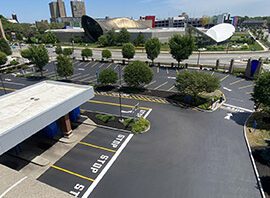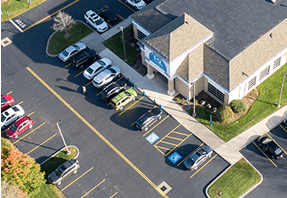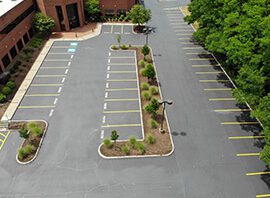Aug 26, 2025 | 1-800-Striper NE Boston
Pittsburgh, Pennsylvania a city steeped in industrial heritage and architectural charm is undergoing steady urban expansion. As residential, commercial, and public spaces grow in number and density, one element remains critical yet often overlooked: effective parking lot striping. While seemingly simple, parking lot striping plays a pivotal role in ensuring safety, compliance, accessibility, and efficient use of urban space.
This article explores the intricate landscape of parking lot striping in Pittsburgh, covering the latest techniques, the region’s unique challenges, regulatory considerations, economic significance, and opportunities for innovation and sustainability in the sector.
Parking lot striping involves the application of clearly visible lines, symbols, and directional markers on pavement to organize vehicle and pedestrian traffic within parking areas. This process, commonly referred to as line striping, holds importance that extends beyond aesthetics:
In urban centers like Pittsburgh, where space is limited and demand is high, effective striping is essential for functionality and urban harmony.
Technological and material advancements have revolutionized parking lot striping over the years. In Pittsburgh, where weather variability poses unique demands, the selection of materials and application methods must be strategic. Below are the most used techniques:
1. Alkyd Striping
Alkyd striping paint is an oil-based solution known for its durability and strong adhesion to asphalt surfaces. It’s a popular choice for roadways and parking lots due to its resistance to wear and tear. In climates like Pittsburgh’s, where weather conditions can vary drastically, alkyd paint offers reliable performance and longevity.
2. Water-Based Striping
Water-based paint is an environmentally friendly option commonly used for pavement marking. It’s easy to apply, dries quickly, and emits fewer harmful fumes compared to solvent-based alternatives. While it may not last as long as alkyd paint, it’s ideal for areas with lighter traffic and where sustainability is a priority.
3. Reflective Striping
Reflective striping enhances nighttime and low-light visibility by incorporating glass beads or reflective materials into the paint. This is essential for safety in high-traffic areas, particularly in places like Pittsburgh where fog, rain, or snow can reduce visibility. Reflective striping is often used on highways, crosswalks, and busy commercial zones.
4. Thermoplastic Striping
Thermoplastic striping involves applying a heated plastic-based material that bonds with the pavement as it cools. This method produces thick, durable markings that can withstand high volumes of traffic. It’s especially suitable for Pittsburgh’s busy streets and commercial lots that require long-lasting, highly visible markings.
5. Epoxy Striping
Epoxy striping uses a two-part resin system to create tough, chemical-resistant markings. It’s commonly used in industrial settings, parking garages, and areas with frequent exposure to oil or heavy machinery. Epoxy offers excellent adhesion and longevity, making it a top choice for surfaces that demand superior performance.
Pittsburgh’s continental climate, characterized by cold winters and hot summers, introduces specific challenges for parking lot striping:
To combat these effects, striping contractors in Pittsburgh often employ specialized primers, apply multiple coats, or schedule projects during optimal weather windows (typically late spring to early fall).
In Pittsburgh, parking lot striping must align with both federal ADA requirements and local city ordinances. These regulations dictate:
Non-compliance can result in legal penalties, fines, and lawsuits, making professional guidance essential for business owners and property managers.
As urban infrastructure modernizes, the parking lot striping industry is evolving with it. Several trends and innovations are shaping the future of striping services in Pittsburgh:
1. GPS-Guided Striping Equipment
High precision striping machines integrated with GPS systems are becoming increasingly popular. These machines can reduce human error, optimize layout, and ensure symmetry particularly useful in complex or large parking structures.
2. Eco-Friendly Materials
With rising environmental awareness, manufacturers are producing low-VOC paints and recycled thermoplastic materials that reduce environmental impact while maintaining performance.
3. Smart Parking Integration
In the future, parking lot striping may incorporate sensor-based systems, digital signage, and real-time space detection to facilitate smart parking and reduce congestion in busy areas.
4. Modular Pavement Markings
Pre-formed thermoplastic symbols and templates are gaining traction as faster, more efficient alternatives to on-site painting, particularly for handicap symbols, arrows, and stop bars.
Given the importance of compliance, aesthetics, and material longevity, professional striping services are indispensable. Companies like 1-800-Striper of Pittsburgh provide expertise in:
Hiring experienced contractors ensures that parking facilities are not only up to code but also visually appealing and long-lasting.
The parking industry in Pittsburgh is more than a logistical consideration; it’s a significant economic engine. Efficient parking design and maintenance:
According to the Bureau of Labor Statistics, parking services including striping provide employment in areas such as field installation, project management, and safety compliance.
Compared to cities with milder climates like San Diego or Austin, Pittsburgh presents harsher environmental conditions that necessitate more frequent maintenance and strategic material use. For instance:
Modern striping initiatives in Pittsburgh are guided by two core principles:
1. Sustainability
Contractors are increasingly choosing low-emission materials, energy-efficient equipment, and waste-reduction practices to align with environmental goals.
2. Safety
Innovative layout designs include:
The parking lot striping industry is on the brink of transformation, thanks to automation, digitization, and green materials. In the next decade, we can expect:
These advancements will not only make striping more precise and sustainable but also contribute to Pittsburgh’s broader smart city initiatives.
Q: How often should parking lot striping be refreshed in Pittsburgh?
A: Refreshing is recommended regularly to maintain visibility and safety. High-traffic areas or lots exposed to harsh weather may require more frequent touch-ups to keep markings clear and compliant.
Q: Are there incentives for using eco-friendly striping materials?
A: Some city contracts and LEED-certified projects may offer preferences or incentives for using low-VOC or recycled materials.
Q: What’s the cost of professional striping in Pittsburgh?
A: Pricing varies based on the size of the lot, type of materials used, and project complexity. Smaller lots tend to be more affordable, while larger or commercial projects may require a higher investment due to additional layout and compliance needs.
Q: Can I stripe a lot myself to save money?
A: While DIY kits exist, professional services are recommended for compliance, accuracy, and long-term durability.

Had our parking lot paved and found ourselves needing lines. Their team was fantastic from start to finish. They took the time to give great advice and listened closely to our company’s needs.

They are very responsive and complete the work in a timely fashion. I have used them for 18 years and have never had any issue with their work. Very highly recommended.

They are very easy to work with and have a highest level of attention to detail. They are very knowledgeable and passionate about parking lot striping. Their quality of work is outstanding!
COPYRIGHT © 1999-2025 | ALL RIGHTS RESERVED STRIPER INDUSTRIES, INC. | Privacy Policy